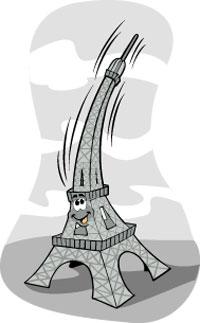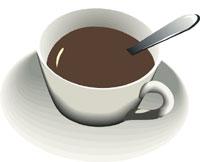By heat
We go to Paris to start the journey around the heat. And after arriving in Paris, where to start if not from the Eiffel Tower? However, before leaving and since we are very curious, we have acquired a guide to, among other things, know that the length of this tower is three hundred meters. But then we have a question: when have you measured it? In winter or summer? That is, when it's hot or cold in Paris? This great iron tower will not be the same temperature.
We know that climbing a wedge of three hundred meters of iron with a degree stretches approximately 3 mm. Therefore, the Eiffel Tower will work similarly when the temperature changes. If in Paris the sun sounds, when it is hot the iron tower heats up, for example, to +40ºC, while when the day is rainy and cold, the temperature can reach 0º C, even below. Therefore, and as an example, if the temperature difference is 40ºC, the length of the Eiffel tower can vary by 3 mm/ ºC x 40ºC = 120 mm, that is, 12 cm.

In order to check all the above, direct measurements have been made at the Eiffel Tower. For this purpose a special alloy thin wire, called “inbar”, formed by steel and nickel, whose length hardly varies with temperature. As you might think, what was said in theory has been shown in reality. Therefore, the top of the Eiffel Tower on warm days is approximately ten centimeters higher than on cold days. In addition, the “putting” of a part of iron of ten centimeters does not cost anyone, that is, it is generated from the “vacuum”. What a wonder!
Glass saving
Before throwing the hot coffee to the cup, we always put a spoon inside the cup and better if it is silver. This saves a lot. At home we do it simply as usual, but does that have a habit without scientific reasons or without reason? When we often pour very hot water into cups or glasses we have seen them break. We will analyze the cause of this phenomenon.
The basis of this phenomenon lies in the different dilation of glass. When hot water is poured into a glass, the wall of the glass is not heated in the same way in all its thickness, that is, while the inner layer is immediately heated, the outside remains cold. Therefore, the heated inner layer begins to dilate, but not the outer layer. That creates great pressure through the wall, such a well-known class! we hear it … and the glass is broken into a thousand pieces.
Let no one think that buying thicker glasses will discard the problem, which will happen backwards. Thick vessels are weaker than thin ones in this phenomenon and break more easily. It is not difficult to understand that when the walls are thin, the thermal balance is achieved faster and the dilation of all the layers is practically the same, while in the thick wall vessels this phenomenon is given upside down.
But if you choose thin wall glasses readers, remember that the background should also be thin. When we pour hot water it is the bottom that is heated especially and if it is thick, even if the walls are very thin, the container breaks the same.
As the walls of a glass container are thinner, we can heat them more safely. The chemists use glass containers with very thin walls and put themselves on fire with boiling water without fear of breaking.
As we can think, the best container would be that when heated did not have any dilation. Quartz expansion is minimal, almost twenty times smaller than glass. We can heat everything we want a quartz container and it does not break us. Once the container is placed in an incandescent position, it is immersed in cold water and will remain exactly the same. This is due, on the one hand, to the said above, that the coefficient of expansion of quartz is very low and, on the other, that the thermal conductivity of this material is much greater than that of glass, so the thermal balance is achieved quickly inside.

We have already seen why the containers break when heating the sharp, but the same happens if we cool them sharply. If we put a very hot glass container in the ice, the outer layer will cool immediately, but not the inner one, so as the outside decreases, the other will continue the same, generating pressure and breaking the container. Therefore, if we store hot food in a glass container, do not cool it by putting it in cold water, since the risk of breakage is very high.
Before we mentioned the spoons, why? Why is it recommended to place the teaspoons in the containers before putting hot water?
As we have seen, the cause of the glass break is the thermal jump between different layers, since when it is large the pressure will also be elevated. When the difference is small, virtually all layers are heated at once and no reduction occurs. This is the advantage of warm water: the small thermal jump that produces warm water between the different layers. And the spoons? When the liquid falls to the bottom of the container, the glass, with a poor thermal conductor, has the possibility of giving part of its heat to the spoon, which is metallic and therefore good thermal conductor. This slightly decreases the temperature of the liquid and the liquid that comes into contact with the wall of the container is more temperate than the heat.
Now we can continue to pour hot coffee without danger of breakage, because the cup in its entirety has had the possibility of heating a little (or many). In short, by putting the metal teaspoons in the glass, it slows down the heat jump, preventing the cup from breaking.
And why better a silver spoon? That is also very easy to understand. Silver is a very good heat conductor, so it takes water heat much faster than other materials. Therefore, if the silver teaspoons are stuck in the hot coffee and we take them with our fingers, we will burn, but with other materials, such as cuprés, it will not happen to us. Although the teaspoon you have put on top of the table with the coffee seems to be beautiful, you can know if it is silver or not: if you smoke, silver; if not, who knows!
Buletina
Bidali zure helbide elektronikoa eta jaso asteroko buletina zure sarrera-ontzian











